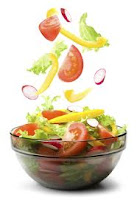Well, summer is just around the corner, and spring is already here (on the calendar, that is). And this time of year is the best time to make a clean, refreshing salad on those hot, humid days. But let's face it, who wants the boring old iceberg lettuce with matchstick carrots and croutons every night? And don't even get me started on those store-bought dressings! Why can't you make a fun, exciting salad every night of the week that incorporates all kinds of great nutrients, hits all the major food groups, and is tasty and fun at the same time? I know what your thinking: I work all day, how am I supposed to come up with this all on my own?? That's why you have me here! Making satisfying, sassy salads is an easy 4-step process. Let me break it down!
Step 1: Build The Base
 The base of your salad should be just like the base of your house, really sturdy. When I say sturdy, I don't mean something structurally strong, but nutritionally strong. Most salads use a base of iceberg lettuce, which is fine. But lets face it, iceberg lettuce is a little boring and not as nutrient-dense as some other greens that could be used. The darker the green, the more sturdy your base is going to be. Instead of that iceberg lettuce, why not try romaine? Even better than romaine, what about that beautiful dark green spinach? Or, if you want to jazz it up even more, try a more flavorful green such as arugula, watercress, or escarole. Whatever green you choose, make sure it is sturdy!
The base of your salad should be just like the base of your house, really sturdy. When I say sturdy, I don't mean something structurally strong, but nutritionally strong. Most salads use a base of iceberg lettuce, which is fine. But lets face it, iceberg lettuce is a little boring and not as nutrient-dense as some other greens that could be used. The darker the green, the more sturdy your base is going to be. Instead of that iceberg lettuce, why not try romaine? Even better than romaine, what about that beautiful dark green spinach? Or, if you want to jazz it up even more, try a more flavorful green such as arugula, watercress, or escarole. Whatever green you choose, make sure it is sturdy! Step 2: Pick Your Protein
Step 2: Pick Your ProteinEvery salad you make should include a protein. A protein will help keep you fuller longer, otherwise you may find yourself hungry again after a couple of hours. But don't choose a sliced baked chicken breast every time! Your protein should be unique and different for all your salads. Why not cut up the left over steak from last night's dinner? Maybe your in the mood to open a can of black beans and sprinkle some edamame on as well. Don't forget your cheese contains quite a bit of protein, maybe an array of different cheeses will be your protein. How about fish? A little salmon, cod, or tilapia fillet could be a perfect protein pick. Finally, some slivered almonds or chopped walnuts could add a bit of protein along with a satisfying crunch. There are so many great choices!
Step 3: Jazz It Up!
 This is the most fun part of making your salad: putting on all of the fixings! You can make it as fun and unique as you want. Add anything you have in your refrigerator such as: chopped tomato, onion, cucumber, zucchini, pepper, olive, carrot, avocado, or kohlrabi. You can even put a few fresh sweet corn kernels on the top. Don't forget your herbs! Chop up some of your favorite herbs to add flavor and leaving out the calories. When you think you are finished jazzing up your salad, check it out. Does it have a lot of color? Does it look pretty and appealing? The more color you add and the more visually appealing your salad is, the more satisfaction you will get out of eating it. Take the time to make it look amazing, even if its just for you. You taste your food first with your eyes, so generate a salad you can't take your eyes off of!
This is the most fun part of making your salad: putting on all of the fixings! You can make it as fun and unique as you want. Add anything you have in your refrigerator such as: chopped tomato, onion, cucumber, zucchini, pepper, olive, carrot, avocado, or kohlrabi. You can even put a few fresh sweet corn kernels on the top. Don't forget your herbs! Chop up some of your favorite herbs to add flavor and leaving out the calories. When you think you are finished jazzing up your salad, check it out. Does it have a lot of color? Does it look pretty and appealing? The more color you add and the more visually appealing your salad is, the more satisfaction you will get out of eating it. Take the time to make it look amazing, even if its just for you. You taste your food first with your eyes, so generate a salad you can't take your eyes off of! Step 4: Drizzle With Dressing
Step 4: Drizzle With DressingNow that you have made a beautiful, sassy salad, don't douse it in all that store-bought dressing! Why not make your own tangy vinaigrette? Making your own salad dressing is simple and fun and you only need a few ingredients. Start with an olive oil or canola oil. Then, your going to add an acid to that oil in a ratio of one to one. Now, I know what your saying: what the heck is an example of an "acid" and what do you mean by a ratio of one to one? An acid could be any type of vinegar (balsamic, apple cider, white wine, or red wine), lemon juice, lime juice, or orange juice. Notice all these liquids are acidic. A ratio of one to one just indicates that if you are putting in 1/2 cup of oil, you will also need a 1/2 cup of acid. Or if your putting in 1 cup of oil, you will need 1 cup of acid. The amounts should be equal. Then, add some fun twists! What about some sweetness? Add some brown sugar, granulated sugar, or honey! What about some heat? Add hot sauce or chili garlic paste! In the mood for a little salt? Add soy sauce or worcestershire sauce! Lastly, add some orange, lemon, or lime zest to freshen it up and don't forget to add salt and pepper to taste, or any other spices you think would make it great.
Here are some of my most favorite sassy salads and dressings that I enjoy all summer long!
Crisp Citrus Salad
2 cups romaine lettuce, chopped
1 cup arugula
2 tbsp dried blueberries
2 tbsp dried cherries
2 tbsp dried yellow raisins
2 tbsp walnuts, chopped
1 oz crumbled chevre
1/4 cup olive oil
2 tbsp lemon juice
1 tbsp orange juice
1 tbsp Dijon mustard
1 tsp honey
1 tsp lemon zest
1/4 tsp fresh thyme leaves
1/4 tsp salt
pepper to taste
1. Layer salad in the following order: Mix of greens, blueberries, cherries, raisins, walnuts, and chevre.
2. Whisk the remaining ingredients and drizzle on salad. Season with pepper and enjoy cold.
Tangy Thai Beef Salad
5 cups spinach
1/2 red pepper, sliced thin
4 oz lean steak, sliced thin
2 fresh basil leaves. sliced thin
fresh cilantro, sprinkled on top
1/2 cup soy sauce
1/2 cup canola oil
1/4 cup lime juice
1/4 cup brown sugar
1 tbsp diced garlic
1 tbsp chili garlic paste
1.) Layer the salad in the following order: spinach, beef, red pepper, onion, basil, and cilantro.
2.) Whisk the remaining ingredients and drizzle over salad. Enjoy cold.
Classic Cobb Salad
3 cups romaine lettuce, chopped
2 cups spinach
4 oz baked chicken breast, sliced thin
5 tomato slices
1 hard boiled egg, quartered
1/4 of an avocado, diced
2 tbsp blue cheese crumbles
2 tbsp diced ham
1/2 cup olive oil
1/4 cup red wine vinegar
3 tbsp lemon juice
1 tbsp Dijon mustard
1 tbsp worcestershire
3 tsp minced garlic
1 tsp salt
1 tsp pepper
1.) Lay the romaine and spinach on the plate. Put the following ingredients in rows, beginning from the left: chicken, tomato, egg, avocado, blue cheese, and ham.
2.) Whisk the remaining ingredients and drizzle over salad. Enjoy cold.
Good luck and have fun creating and making your own sassy salads!!

















